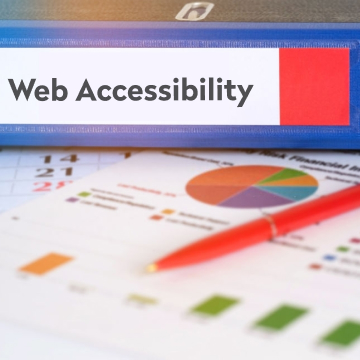In short:
- Only 2 percent of the world’s websites meet accessibility standards.
- The average settlement in an ADA-related lawsuit ranges between 3,000 USD to 30,000 USD.
- ADA requires that your website provide full, equal, meaningful access and effective communication.
- Conforming to WCAG 2.1 AA and publishing an accessibility statement is currently the best practice to follow.
- ADA and WCAG compliance widgets and toolbars are a scam and they will neither make your website immediately accessible nor provide immunity from legal action for violations. In other words, they are absolutely worthless.
- Non-conformance can be a major legal liability and can invite demand letters and multiple lawsuits.

What is ADA? And what does the law imply?
ADA is the Americans with Disabilities Act, and it governs accessibility in the United States of America. In essence, the law implies that your services need to be accessible, otherwise you are discriminating against people with disabilities.
Despite there not being a direct mention of websites in the actual statement of the law, the United States judiciary has more often than not included websites and apps (regarded “places of public accommodation”) under the services ADA governs. And this means that your website can potentially invite lawsuits if it is not accessible and if it can be shown to be commercial in nature.
So what can cause lawyers to sue you? How do they decide whether your website is accessible or not? Currently, the accessibility standards most commonly referenced by the United States courts and the Department of Justice are WCAG 2.0 AA and WCAG 2.1 AA. Most plaintiffs try and find if there are specific technicalities from those guidelines that your website doesn’t comply with (a redundant link, for instance).
Here is where it starts to get confusing: WCAG is not the law (it is merely the set of technical standards referred to by the law as a healthy set of guidelines in several cases), and there is in fact no formal legal requirements for web accessibility for private entities in the United States.
The significance and the subsequent punishment for accessibility issues vary from case to case based on the nature and the number of the issues. However, since the option of litigation lies only with the plaintiff and their lawyer, they would most likely go ahead and litigate. Suing your business or sending you a demand letter will lead to a loss of your time, money, and resources, and that means despite technically not violating the law, you still incur a loss.
Let’s examine the actual statement for a second. Title III of the ADA stresses upon the “full and equal enjoyment” of services and facilities offered by any place of public accommodation, and therefore the ultimate aim is to ensure that everyone (including people with disabilities) can enjoy the content, features, tools, etc. on your website to a full and equal manner. Therefore, what the ADA is really trying to do is to get websites to provide meaningful access and effective communication to people with disabilities.
Does this mean that I am somehow violating the law if I don’t follow the WCAG guidelines?
Not really. Several statements from members of the judiciary and even from the government’s own accessibility blog have maintained that as long as there are no specific accessibility requirements as a final rule, there is room for flexibility in how institutions comply with the ADA.
So legally speaking, why should I comply with the ADA then?
- The ADA is a strict liability law. This means there are no excuses or defenses for any instances of violation.
- Individual state courts have specific anti-discrimination laws (such as the Unruh Act and the New York Human Rights Law in California and New York respectively). These are similar to the ADA, but with harsher penalties for violation, and therefore a lawsuit under ADA can invite additional lawsuits under these laws.
- Industry-specific laws (such as the Fair Housing Act for real estate) are used for further suing website owners depending on their industry of operation.
- Settlements are often in the 3,000 USD – 30,000 USD range, depending on several factors including the size of the business, the nature of violations, and so on.
- Under the ADA, a business owner can be sued several times by different people (even if you have previously settled a case) and the only way to avoid lawsuits and demand letters is to become accessible. Additionally, if you have been sued, there is no notice period issued for accessibility compliance, which means you can be continually sued by several parties.

What is WCAG? And how do I make my website ADA compliant?
WCAG stands for Web Content Accessibility Guidelines. These are published by the World Wide Web Consortium (W3C) under the Web Accessibility Initiative (WAI). Aimed primarily at making the internet experience for all users uniform and efficient (while leaving room for all creative liberty), the WCAG standards have constantly evolved towards being as inclusive as possible in their approach to accessibility.
There are several versions of WCAG (1.0, 2.0, 2.1, 2.2, and eventually a 3.0 that is to come), and three different conformance levels (A, AA, and AAA). Each successive version includes all the guidelines of the previous version, plus a few additional requirements (so 2.1 AA, for instance, is just 2.0 AA with 12 more things to cover).
The version most commonly referred to by the law for accessibility guidance is the WCAG 2.1 AA (and in some cases, it has even been adopted as the law for web accessibility). However, just reading the contents of WCAG 2.1 AA can be time-consuming, let alone executing those changes on your website.
Broadly, the WCAG criteria are classified into five sections: alternatives (whether all visual media has complimentary text that serves the same purpose), presentation (how the content is presented on your website), user control (how the content can be accessed or navigated through), understandability (whether the purpose of all content, webpages and/or links are clear), and predictability (the behavior of the website and the overall ease of user experience it offers).
A considerable number of things on the WCAG checklist can easily be struck off while developing the website if meticulous care is taken to establish the primary purpose of the website throughout the website, and if all possible user paths are taken into consideration.
When it comes to actual accessibility, three things crop up frequently:
-
JavaScript-based toolbars or widgets
Not only do these NOT work, but they also double up as a security threat to your website. In fact, it makes for a stronger case for non-compliance (certain people are forced to access the website via a toolbar or a widget, whereas the rest can directly experience the website and its content). Do not fall for overlays, widgets, and toolbars.
-
Automated website accessibility scans
Scans can be helpful in that they immediately identify a fraction of accessibility issues and notify you, so you can fix them. All scans have an internal checklist that is cross-verified against your website. This can flag up to 25% of the accessibility issues at best, however, you will need to manually fix these issues.
-
Accessibility audits:
An audit is a manual, formal evaluation performed by an accessibility expert who tests a website against the WCAG guidelines and delivers a report outlining all the accessibility issues to the client. Be wary of marketing agencies (and even some specialized accessibility agencies) that claim to audit websites but instead merely run an automated scan.
ADA-related issues exist across websites irrespective of scale, and the smart thing to do is to identify and fix accessibility issues across all the versions of your website and mobile apps. This can be a tiring process as it takes months to become ADA compliant. One way to resolve this is to reach out to the best in the industry.
Right now, less than two per cent of all websites are ADA compliant. You don’t want to be one of the companies receiving a wave of lawsuits and demand letters your way and lose a massive amount of time, money, and resources to the fight. Hence, CodeGlo. At CodeGlo, we offer ADA compliance services that thoroughly audit websites and go beyond merely reporting the issues: we offer to remediate them as well. We have already started rolling out ADA compliance service to all our existing clients. This ensures that you can continue working on what matters most to the competitive side of your business, without worrying about possible website issues distracting you. Talk to us before it’s too late.







